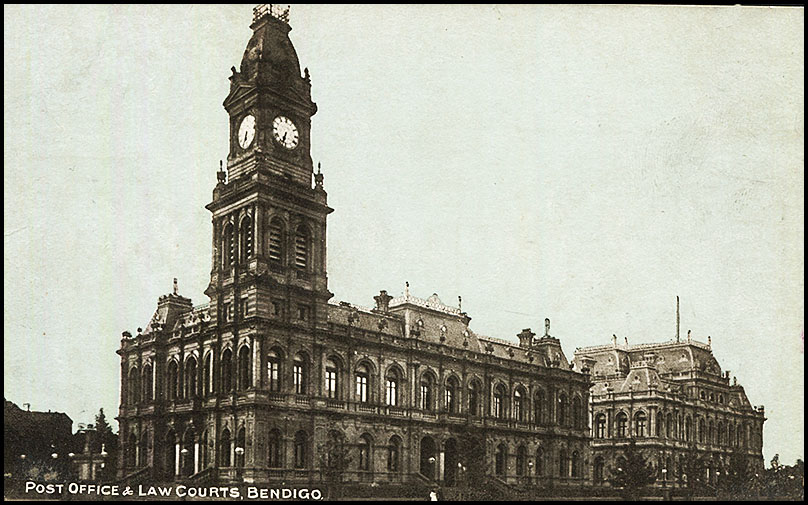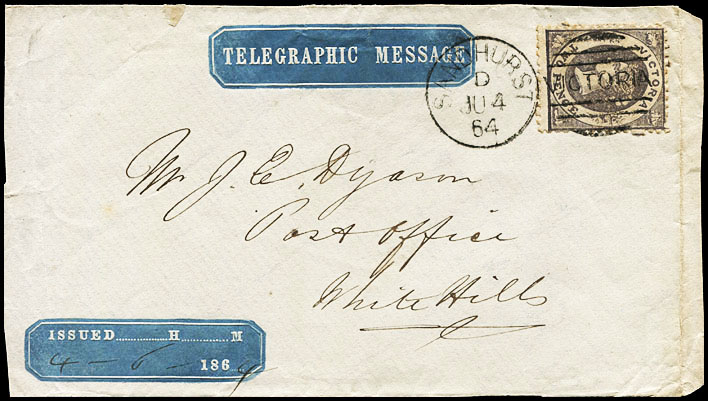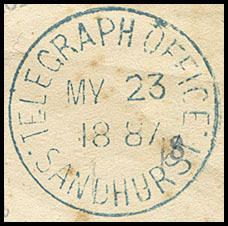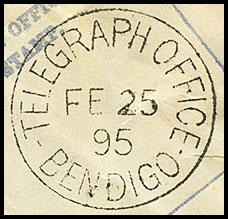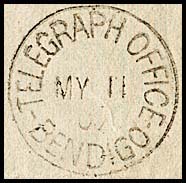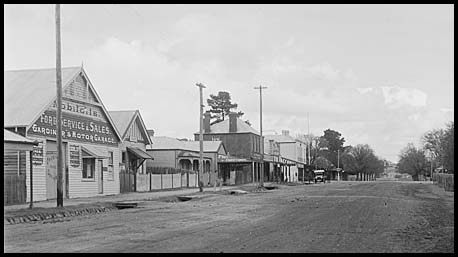Telegraph Offices on the first lines (Northen line) - 1854 to 1856.
- Australia 1901-1988
- New South Wales
- Queensland
- South Australia
- Tasmania
- Victoria
- Western Australia
- International
- Special aspects
The Telegraph Offices on the first line which are described here are:
| Ballarat | Bendigo (Sandhurst) | Geelong | Gisborne | Kyneton | Port Melbourne (Sandridge) |
| Queenscliff | Williamstown. |
Bendigo (Sandhurst).
The Telegraph Office opened in January 1857. The Sandhurst Post Office was renamed Bendigo about June 1891. Up to 1 January 1854, Sandhurst had been known as Bendigo Creek. The Gazette of 5 December 1856 listed acceptance of the tender from Campbell and Thompson for the erection of a Telegraph office at Sandhurst for the sum of £1,162. On 8 January 1857, The Argus reported: "Some parties working at the back of the new telegraph office, opposite the office of this paper, in the old ground, yesterday, dropped upon a nugget of 27lbs. weight, which was subsequently disposed of to Mr. Bannerman. The information reached us through the most reliable channels and it strikes us that those who have gone to Dunolly and elsewhere had better have remained upon old Bendigo". Almost immediately after the Office opened, questions were asked in the Legislative Assembly about the difficulties of communication. On 28 January 1857 in the Legislative Assembly "the attention of the Commissioner of Customs was called to the fact of the telegraphic communication with Sandhurst being broken, and explained that it arose from some of the posts having been carried away by bullock teams". |
|
|
|
The Herald of 9 April 1879 reported: "Messrs E. Clark, Mclntyre and Thompson Moore, M's.L.A., and Mr Sterry, Mayor of Sandhurst, waited on the Minister of Public Works today and asked him to place on the Estimates a sum of money that would cover the expenses of a new public building which should include all the public offices and those of the Post and Telegraph. The present building, they urged, was not imposing enough for so large and important a city as Sandhurst. If the Minister of Public Works liked, he could erect the building on whatever site he chose but all they wanted was the edifice. Mr Patterson recognised the importance of having a new and large building erected and thought it should be in the very heart of the city so as to give the Post and Telegraph office a good trade. He did not believe in the idea of burying a magnificent structure in some out-of-the-way place and, with the view of meeting the wishes of the deputation, he would have plans prepared and then see what could be done. Meanwhile they must decide on the site which must necessarily be a good one and in the heart of the city". |
|
|
|
The Ballarat Star of 10 January 1870 reported that "at the Bendigo land sale on Friday, Father Bachaus became the purchaser of the old telegraph buildings and site containing one rood and a little over 20 perches, in Mitchell Street. It was knocked down at £1,000. There was a valuation of £600 upon the building and the upset price of the land was £1,000 per acre".
2. Confidentiality of messages. It was written ito relevant legislation that telegraphic messages had to be treated with the highest level of confidentiality and not disclosed. The significant temptations from the results of the gold and siver mines placed great strain on these requirements. The Mount Alexander Mail of 13 April 1881 was one of many reports abiut the violations of the legal requirements - here at the Bendigo Telegraph Office: "Judging by current rumours, it seems time some action was taken in getting the Minister to make a searching inquiry into the working of the local branch of the Telegraphic Department. There is a good deal more behind the scenes than the messengers' question in the grievance which the deputation from the Stock Exchange desire to lay before the Minister. It has been felt throughout mining circles for a long time past, that the local Telegraph Office is not a secret means of communication between broker and broker, or client and broker and, although we cannot point to any direct evidence in support of it, we may state that there has been strong suspicion that the contents of telegrams have been improperly made use of by individuals interested in market operations. It is only the other day that an instance occurred of the contents of a telegram from a gentleman in Melbourne to his broker becoming mysteriously known to a large investor in mining and it is strongly alleged that one of the rules of the department, to the effect that none of the employees shall engage in mining speculation, has not been strictly observed. Again, we hear it affirmed that a certain individual has boasted that he is enabled to learn the contents of messages intended for other people. What certainly indicates something being wrong in the department is the action of several brokers sending their messages in cypher, or couched in phrases understood only by their correspondents". |
|
An extract from the Bendigo Advertiser of 22 February 1878 reveals the emergence of a different technology: "TELEPHONE EXPERIMENTS. Last evening about a dozen gentlemen and four representatives of the press assembled in the small room next to the Telegraph operating-room, for the purpose of trying a few experiments with the telephone. Mr. Quarry's patent was the instrument used, and it appears to be very simple in construction and is the same as used and described when the trial of this useful invention was made between Ballarat and Melbourne. On that occasion, although the distance is nearly 100 miles, persons at either end could converse easily and songs were distinctly heard. Last evening the communication was with Eaglehawk but, on account of the vibration, it was some few minutes before anything could be distinctly heard. After that, however, several songs were sung here and the persons at Eaglehawk replied, stating with what success they were heard. Sandhurst then called upon them for a song and "Simon the Cellarer", "Let me like a soldier fall" and "There is a happy land" were very plainly heard, whilst other songs were not quite so distinct. On Wednesday evening an experiment was tried between the telegraph office and the railway station with great success but, as we before said, on account of the vibration, some sentences were lost last night. Taken as a whole, however, the trial must be pronounced a great success and Mr. Quarry is to be congratulated on having made his instruments so perfect. The invention, as yet is in its infancy, and no doubt ere long will be so improved upon that it will come into general use in large places of business on account of the ease with which it can be conveyed from one part of a building to another. Since the above was written, we have heard that the reason why communication with Eaglehawk was not heard at once was owing to the earth-plate being a bad one. This was remedied by Mr. Petty by connecting the wire another way, and then the communications were very distinctly heard in Eaglehawk". |
|
|
Promotion. It will be gratifying to the friends of Mr. J. J. Barry, who for many years has been head operator at the Telegraph Office, Sandhurst, to learn that he has been promoted to take charge of the Victorian office, in connect with the Tasmanian Cable Company at Flinders. Mr. Barry, during the time he has been in Sandhurst, has won the respect and esteem of all those who had the pleasure of forming his acquaintance and, in his official capacity, he was always courteous, attentive and obliging. He leaves Sandhurst by the noon train to-day and we wish him every success in his new sphere of action" 3.1: The story of Mr. Vibert. On 28 September 1880, the Bendigo Advertiser reported the following: "Some surprise was expressed yesterday when it was stated that Mr. Vibert, who for many years has filled the post of Post and Telegraph master in Sandhurst, had tendered his resignation. He has done so in accordance with the wish of the Government which was expressed in a letter received by him during the latter part of last week. He retires on the allowance made on the basis of tenure of office. He has, however, applied for leave of absence for three months, so that it is probable he will not vacate his position until about the end of the year. It is not known who will be his successor, but the head of the department has intimated unofficially that great changes will yet be made in its working. Great regret has been generally expressed at the loss of such an officer as Mr. Vibert, who has made himself well liked and appreciated both by the public and by those in his office, which latter fact speaks volumes in his favor. He has been most assiduous and a better proof of his close attention to his duties could not be desired than the fact that he has been for over twenty-six and a half years in the Sandhurst Post Office and, during that long period, he has not had six months leave of absence". On 23 March 1882, The Kilmore Free Press reported "In the case of G. W. Vibert, late Post and Telegraph master at Sandhurst, the Government has decided to cancel the order of his dismissal from the service and reinstate him in exactly the same position which he held when called upon by the Postmaster-General to answer certain departmental charges. Mr Vibert was last year criminally tried on three separate occasions for alleged pilferings from the post office funds at Sandhurst. In not one instance did the prosecution obtain a conviction and Mr Vibert now seeks to regain his lost position in the public service. It appears that, before criminal proceedings were instituted against him, he was called upon to answer certain alleged irregularities upon which the subsequent prosecutions were founded. Mr Vibert instructed his solicitor to send a reply to the department, but it is now stated this reply was not forwarded owing to an error on the solicitor's part. Mr Vibert was thereupon suspended and subsequently dismissed. His dismissal has been cancelled but he is still under suspension pending the investigation of the special board appointed last week to inquire into the departmental charges". On 12 June 1882, the Geelong Advertiser followed up that story with: "The report of the board which has recently been sitting at Sandhurst for the purpose of enquiring into the case of Mr. Vibert, late Post and Telegraph master at that city, has been placed in the hands of the Postmaster-General. The board, in accordance with the instructions of the Government, limited the scope of their investigations to strictly departmental matters and studiously avoided all questions directly bearing upon the charge of larceny - of which Mr. Vibert had been acquitted by a jury. The report will be laid before the Executive Council on Monday and, in the meantime, the Postmaster-General declines to allow its purport to be made public". |
|
|
The earliest evidence of the operation of the Sandhurst Telegraph Office is a telegram delivery envelope (VC-EO-2B) posted from Sandhurst for a message to ??? on 4 June 1864. |
|
|
There are three formats for Telegraph datestamps for Bendigo:
|
5.1: Belt & Buckle date stamps:
|
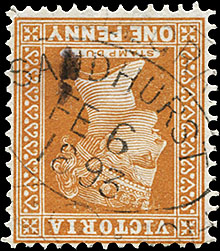 6 February 1893 (latest recorded date) . Provenance: |
|
2: Bendigo: 1 hole.
|
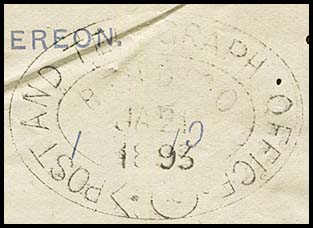 21 January 1893. Used on VC-DO-14 for form but see Northcote for form with B&B Northcote. |
|
| 5.2: TELEGRAPH OFFICE SANDHURST. Sandhurst at base. Date in two lines and has separation dots.
|
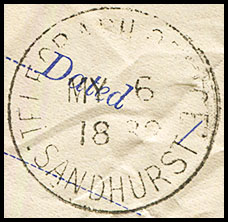 6 May 1882. Used on VC-DO-10. |
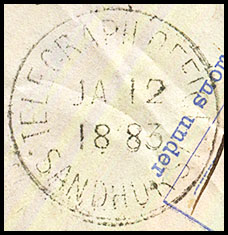 12 January 1883. Used on VC-DO-10. |
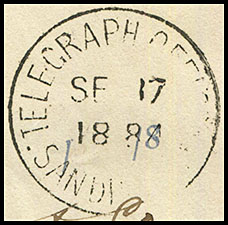 17 September 1884. Used on VC-DO-10. |
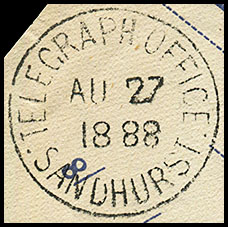 27 August 1888. Used on VC-DO-10. |
|
|
|
| 5.3: TELEGRAPH OFFICE BENDIGO (steel).
There were four formats for this heading in steel which can be easily distinguished from the wording at the top and the diameter. |
||||
|
Used on VC-DO-15B. |
Used on VI-DO-2A.
|
||
|
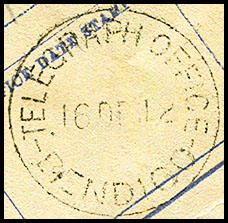 16 December 1912. Used on VI-DO-3Da. | 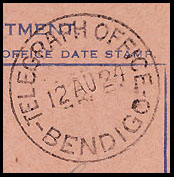 12 August 1924. Used on AB-DU-3B. |
||
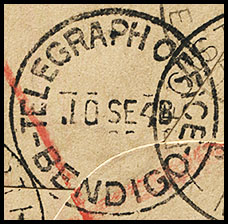 10 September 1948. Used on the reverse side of a registered 2½d PSE to Perth with two other cancellations on the embossed image and additional stamps. |
||||
Not included in WWW. Also used on some now scarce philatelic covers on 12 November 1955 for the 2nd Philatelic Conference of the Victorian Philatelic Council. |
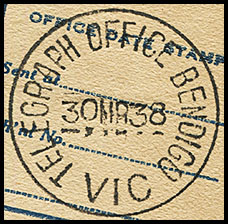 30 March 1938. Used on AB-DO- |
|||
|
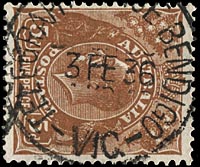 3 February 1936. |
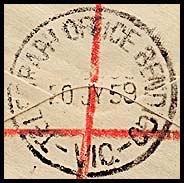 20 July 1959. |
||
| 5.4: TELEGRAPH OFFICE BENDIGO. There may have been three formats with this heading in rubber: |
|
|
|
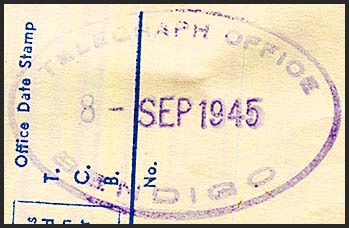 8 September 1945. Used on AW-DO-10Aa (44) ERD. |
|
|
||
|
||
6. Slogans advertising the Telegraph.
|
|
Datestamp: Circle (diameter: 21 mm). Base inscription: VIC. Characteristics: Only recorded date of this format: Number in the Census: 1. |
 17 March 1939. |
|
Telegraph Offices were also opened in three locations around Bendigo:
|
 A straight line Bendigo handstamp was also issued for use with telegrams (see VI-DO-1B). |
| Kyneton.
The Telegraph Office was opened in April 1857. The Gazette of 5 December 1856 listed acceptance of the tender from Campbell and Thompson for the erection of a Telegrah office at Kyneton for the sum of £1,162. The Post Office had changed its name from Mount Macedon on 1 January 1854. |
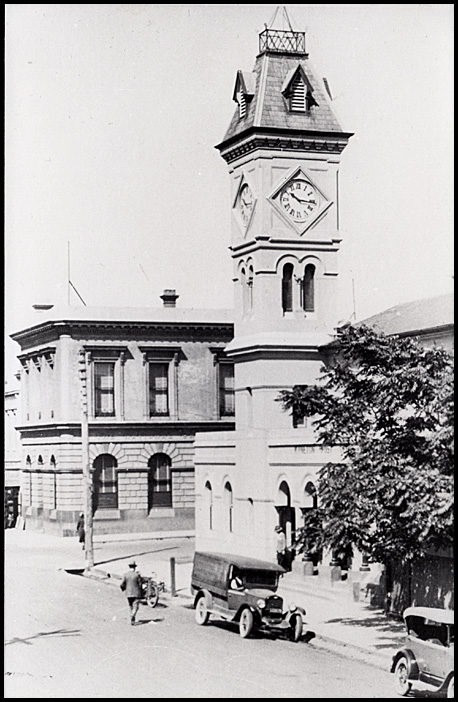 Kyneton Post & Telegraph Office about 1920. |
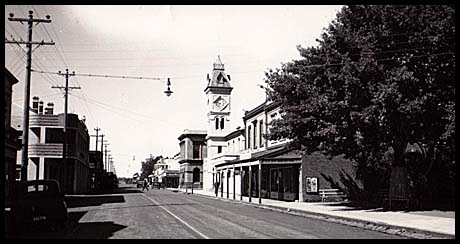 Looking towards the Post & Telegraph Office. |
|
On 19 December 1868, the Kyneton Guardian reported "It is, we believe, a fact that Mr Groves, who for many years has been Postmaster and Telegraph manager in Kyneton, is be removed to Kilmore. His placewill be filled by MrBristow of Kilmore". On 12 May, 1869 the Kyneton Guardian reported "The Kyneton Post and Telegraph Offices were inspected by Mr McGowan on Saturday and a number of repairs pronounced necessary. These repairs are, we understand, to be proceeded with at once and, meanwhile, temporary offices will have to be found for the transaction of the business. It would be far better, and cheaper in the long run, if the building were condemned altogether and a new one erected. The existing offices are a disgrace to the Government and a discredit to the town, to say nothing of their being altogether insufficient for the transaction of the public business". |
|
On 20 December 1877, The Age reported "On the same morning as Woodend was struck, the lightning entered the Kyneton Telegraph Office and, flying from the wire to the lead gas pipe, knocked a hole in it and ignited the gas. An almost similar accident occurred at the office two or three years ago. The accident happened at night and, when Mr. Bristow entered the office, he found the woodwork of the window on fire which was, however, easily extinguished by a few buckets of water". "A telegraphic mistake of an amusing kind, but which at the same time occasioned much pain and annoyance to some of the persons concerned, was made (says the Argus) on Friday in the transmission of a message from Kyneton to Melbourne. A message was sent stating that Mr B. Winter Kelleher, barrister, was "kept to-day, down tomorrow" but the message as delivered read, "killed body, down to-morrow". The news soon spread, nd naturally occasioned deep pain to Mr Kelleher's friends. We are desired to mention that, on telegraphing to Kyneton for further particulars, the welcome intelligence was received that Mr. Kelleher was alive and well" (Ballarat Courier 7 Aoril 1879). |
|
| The following types of telegraph date stamps were issued to the Kyneton Office:
1. a 1 hole Belt & Buckle; 2. a rubber circular TELEGRAPH SECTION datestamp used in violet. |
|
|
|
|
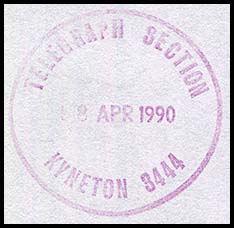 8 April 1990 - presumably archival. |
| The usual postal date stamps were also used on telegrams: | 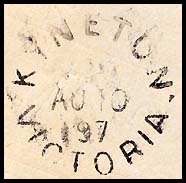 10 August 1897. Unframed date stamp used on |
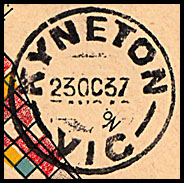 23 October 1937. 2 long arcs. |
.jpg)
